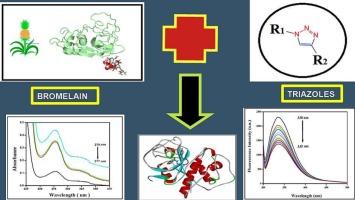Exploring the binding interaction between triazoles and bromelain by spectroscopic and molecular docking techniques
IF 4.6
2区 化学
Q1 SPECTROSCOPY
Spectrochimica Acta Part A: Molecular and Biomolecular Spectroscopy
Pub Date : 2025-09-23
DOI:10.1016/j.saa.2025.126925
引用次数: 0
Abstract
The study of interaction between small molecule and biomacromolecule is highly important in the field of research in biochemistry, pharmaceutical and medicinal chemistry. Here bromelain, a pineapple-stem enzyme is taken as the biomacromolecule and its binding interaction with triazole-based organic molecules are investigated by steady state absorption and emission spectroscopy. The experimental results are supplemented by molecular docking. The triazoles are designed by mimicking the structure of Vorinostat which a bioactive compound. In this paper, we have explored the biophysical interaction of three triazole based ligands with cysteine protease enzyme bromelain for the very first time using steady-state fluorescence and temperature variation experimentally, also compared them with two of our previously published triazoles molecules (SSAM 1 as C-1 and SAM 1 as C-5). The triazole moiety in these compounds are found to be involved in pi-interactions and hydrogen bonding with the amino acid residues present in bromelain and provides stability to the bromelain-small molecule complexes. At lower temperature the binding of these compounds with bromelain becomes relatively more spontaneous. The study shows that the presence of triazole at terminal end in the molecule can make them an inhibitor of bromelain's proteolytic acitivity. But the presence of triazole at cap region provides better binding interaction of the ligand with bromelain under physiological condition.

利用光谱和分子对接技术探索三唑类化合物与菠萝蛋白酶的结合相互作用
小分子与生物大分子相互作用的研究在生物化学、制药和药物化学等领域具有重要意义。本文以菠萝茎酶菠萝蛋白酶为生物大分子,利用稳态吸收和发射光谱研究其与三唑类有机分子的结合作用。分子对接对实验结果进行了补充。三唑类药物是模仿生物活性化合物伏立诺他的结构设计的。在本文中,我们首次利用稳态荧光和温度变化实验探索了三种三唑基配体与半胱氨酸蛋白酶bromelain的生物物理相互作用,并将它们与我们之前发表的两种三唑分子(SSAM 1作为C-1和SAM 1作为C-5)进行了比较。这些化合物中的三唑部分被发现参与了与菠萝蛋白酶中氨基酸残基的π相互作用和氢键,并为菠萝蛋白酶小分子复合物提供了稳定性。在较低的温度下,这些化合物与菠萝蛋白酶的结合变得相对自发。研究表明,三唑在分子末端的存在可以使其成为菠萝蛋白酶水解活性的抑制剂。但在生理条件下,帽区存在三唑使配体与菠萝蛋白酶的结合作用更好。
本文章由计算机程序翻译,如有差异,请以英文原文为准。
求助全文
约1分钟内获得全文
求助全文
来源期刊
CiteScore
8.40
自引率
11.40%
发文量
1364
审稿时长
40 days
期刊介绍:
Spectrochimica Acta, Part A: Molecular and Biomolecular Spectroscopy (SAA) is an interdisciplinary journal which spans from basic to applied aspects of optical spectroscopy in chemistry, medicine, biology, and materials science.
The journal publishes original scientific papers that feature high-quality spectroscopic data and analysis. From the broad range of optical spectroscopies, the emphasis is on electronic, vibrational or rotational spectra of molecules, rather than on spectroscopy based on magnetic moments.
Criteria for publication in SAA are novelty, uniqueness, and outstanding quality. Routine applications of spectroscopic techniques and computational methods are not appropriate.
Topics of particular interest of Spectrochimica Acta Part A include, but are not limited to:
Spectroscopy and dynamics of bioanalytical, biomedical, environmental, and atmospheric sciences,
Novel experimental techniques or instrumentation for molecular spectroscopy,
Novel theoretical and computational methods,
Novel applications in photochemistry and photobiology,
Novel interpretational approaches as well as advances in data analysis based on electronic or vibrational spectroscopy.

 求助内容:
求助内容: 应助结果提醒方式:
应助结果提醒方式:


